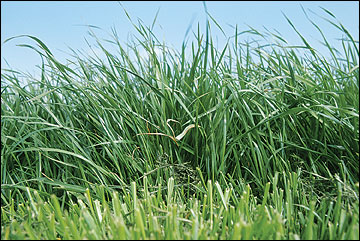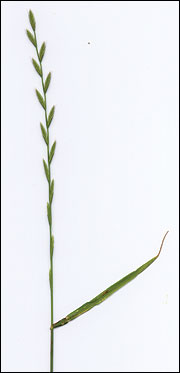Annual ryegrass (Lolium multiflorum Lam.)
Cool-season grasses
Annual ryegrass is increasingly being used for fall and winter pasture, particularly in southern Missouri. Annual ryegrass is easy to establish and, under ideal conditions, capable of producing 2,000 to 3,000 lb/acre of forage within 60 days of planting. If you manage to leave a 3- to 4-inch stubble, total season yields can approach 13,000 lb/acre in southern Missouri. Annual ryegrass retains its forage quality well over winter. In a vegetative state, annual ryegrass is often more than 18 percent crude protein and has acid detergent fiber (ADF) levels of less than 26 percent. As a result, all classes of livestock produce well on it. The drawbacks to annual ryegrass are a lack of winter hardiness, particularly from unadapted cultivars, and annual establishment costs.
 Annual ryegrass
Annual ryegrass
 Yield distribution of annual ryegrass in Missouri.
Yield distribution of annual ryegrass in Missouri.
- Origin: Southern Europe
- Adaptation to Missouri: Best adapted to southern Missouri.
- Growth habit: Nearly sod-forming annual bunchgrass.
- Blade: Rolled in bud, bright green, upper surface dull, prominently ridged, lower surface smooth, glossy, keeled, smooth margins.
- Sheath: Smooth, split, green, pink at base.
- Ligule: Obtuse, membranous, about 1⁄15 inch long.
- Auricles: Overlapping, pointed, blunt and distinct.
- Seed head: Flat, awned, spikelets alternate edgewise up stem.
- Fertilization: 75 lb N/acre at establishment. Apply an additional 40 to 60 lb N/acre in late February and again in early April. Phosphorus and potassium to soil test.
- Timing of production: 60 percent of growth from Feb. 1 to May 1.
- When to begin grazing: When the grass reaches 6 to 8 inches in height.
- When to cut for hay: Early boot stage, typically in late April.
- Lowest cutting or grazing height: 3 inches
- Fall management: Light grazing possible in late fall if a 4-inch stubble is maintained throughout winter.

